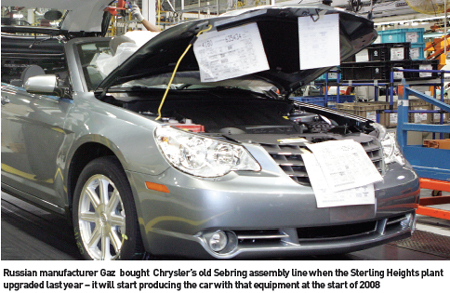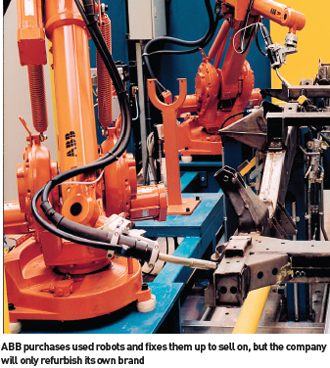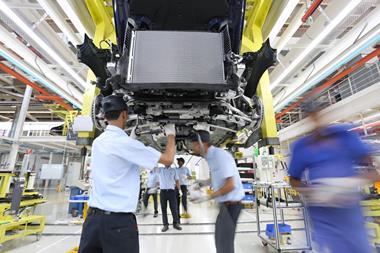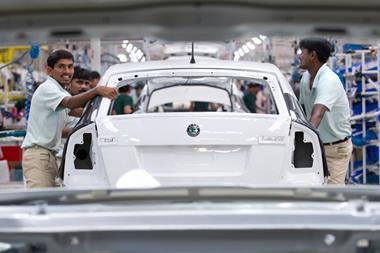With the right expertise in house, using pre-owned presses or reconditioned robots keeps costs down and means less of an impact on the planet. AMS looks at the pros and cons of the second hand market
We regularly talk about the market for new state-of-the-art manufacturing equipment but rarely even acknowledge the market for used equipment. Yet, there is a huge and active market for many different types of used machinery, and trading is global.
Nick Schofield of machinery auction specialist GoIndustry plc explained that the most popular types of used equipment are the hard assets of press shops and stamping plants, and engine and transmission plants. He qualified this further by saying that equipment with long lead times, high capital cost and relatively low installation costs (relative to the machinery cost itself) are the types of equipment his company most frequently deals in.
High installation costs might be considered to be a barrier to buying second hand, but the key is that installation costs should be small relative to the cost of the machinery itself.
Installing a large press is expensive, but not more than the press itself. Installing a new paint shop is a different matter, however. A paint shop is much harder to move as it has fewer hard assets, and most of the installation is building and organisation, or universal equipment such as robots and handling equipment.
Universality is another key to successful second-hand trading. According to Nick Schofield, “the larger bed, higher tonnage presses are the most popular as they can press a broad range of panels.” These can be panels for other industries such as architecture or aerospace, and not necessarily just automotive.
GoIndustry is currently selling presses on behalf of Dana to India and China, and often these can be sold outside of the automotive industry for white goods manufacture, explains Schofield. Transmission manufacturing equipment also sells well, he says: “The machinery is high capital cost and lasts a long time.”
GoIndustry describes itself as the global leader in auction sales and valuations of used industrial machinery and equipment. Like other companies in the sector it operates across industries. The company says it combines traditional asset sales experience with innovative eCommerce technology and advanced direct marketing to service the needs of multi-national corporations, insolvency practitioners, dealers and asset-based lenders around the world.

Generic or commodity equipment, such as handling equipment, conveyers and robots, is also traded frequently according to Colin Knox of automotive engineering contractor, Nicholas Oliver Associates. Knox says that heavy equipment that can be procured locally is left behind.
In the case of an overhead conveyor, for example, it could be that all the tracking would be taken, but not the supports.
There is a high degree of re-use of robots, both by the first owners and by second or third-hand owners. In some cases the robot companies are themselves refurbishing robots and selling them on, although not all robot manufacturers are involved in the refurbishment business.
 Craig Jessup is Service Manager for ABB Robotics in France. Around 10-15 per cent of ABB’s business is for pre-owned robots. ABB identified a need in the market because there were a lot of brokers setting up to sell second-hand robots.
Craig Jessup is Service Manager for ABB Robotics in France. Around 10-15 per cent of ABB’s business is for pre-owned robots. ABB identified a need in the market because there were a lot of brokers setting up to sell second-hand robots.
ABB only refurbishes its own robots and will buy old robots and fix them up to sell on, as well as refurbish them for customers.
Jessup explains: “ABB robots have a good quality reputation. By refurbishing the robots ourselves we maintain some control over quality.”
Clearly independent companies could give ABB a bad name. ABB gives a one year warranty and refurbished robots are ‘like new’.
Being in the second-hand market gives ABB other advantages. It allows the company to have dealings with companies that would not consider themselves to be in the market for new robots. “It helps us grow the market at the low end,” says Jessup. It also gives ABB the opportunity to offer a low-cost solution by offering a mix of used and new robots. Also some customers specifically want old models so they are the same as ones already on the line, “for coherence of the installed base,” said Jessup.
The automotive industry is the main user of robots, so used robots will be traded frequently between companies within the industry.
Robots are also being built to last longer, says Jessup. “In the past big users of robots would run a robot for seven years and scrap it at the end of the life of the vehicle. Now they want to keep robots for two or three model cycles to reduce the cost.”
Jessup gave the example of Peugeot’s Ryton plant in the UK. All the robots used there have been moved to another line in France. The new line will be a mix of new and used robots.
Jarrod Bichon is Vice President of RobotWorx, one of a number of independent robot dealers that operate locally and internationally. “We buy, sell and reintegrate used robots, creating new robot systems from old ones,” he says. Robotworx looks to buy robots from a variety of industries, although “automotive is one of the larger sectors,” he goes on. In some cases they need to be completely reconditioned, but most importantly for RobotWorx, they then need to be integrated. “Integration is our speciality,” says Bichon.
RobotWorx will also sell and support new robots, but the majority of the business concerns reconditioned robots because they keep the cost down and compete well with new robots. Used robots are usually acquired when they are just between one and seven years old but their life can be 15-20 years, often longer. Relatively new robots come on to the market because a job is lost or has expired.
Most companies involved in the reselling of equipment do not make much of the fact that they are providing an environmentally-friendly recycling service. RobotWorx does see being environmentally-friendly as a good way to make its services appear more attractive to the customer, and uses a unique dry-ice cleaning process that replaces the use of caustic solvents. “This is one way of keeping pollutants down, and it offers cost savings for us too,” says Bichon.
Not all used manufacturing equipment sells well. Colin Knox was involved with the disposal of Jaguar assets when the company closed its Brown’s Lane plant. Auctioneers were employed to value the equipment and present it to potential customers, but they had some difficulty disposing of highly specialised equipment such as rolling roads, brake testing and telemetry equipment. “This is all very specific to Jaguar’s needs and would be very expensive to reconfigure,” says Knox.
Some manufacturers of this type of testing equipment set very expensive prices for modifications or revisions and this reduces the potential for resale or relocation.
It is not uncommon for whole plants to be shipped and reassembled. One recent example is the sale of the Dodge Stratus/Chrysler Sebring assembly line and tooling from Sterling Heights, Michigan, to GAZ in Nizhny Novgorod in Russia. Chrysler upgraded the plant in 2006 and had to dispose of the assets. GAZ acquired the line and the rights to produce the car. It will start production at the beginning of 2008, initially using many of Chrysler’s former suppliers.
The sale of the tooling and other assets was conducted via East Coast Trading Company (ECTC), a US-based intermediary exporter. GAZ purchased the equipment from ECTC. “The sale of our outgoing plant tools provides an extended productive life for these high-quality manufacturing assets,” says John Stellman, Vice President – Mergers and Acquisitions, NAFTA and South America for DaimlerChrysler, at the time of the sale.
“In DaimlerChrysler, we found a good source of plant tools,” says Erik Eberhardson, Vice President and Chief Strategy Office, GAZ Group. “We intend to substantially improve the technical level of the automotive products we make. We will offer improved quality for a reasonable price, and I am confident that our customers will appreciate it.”
Another example is the shipping of assets from Rover’s Longbridge plant to Nanjing Automotive’s plant in China. Nanjing acquired MG Rover in 2005 for £50m ($103m) and in early 2006 packaged up 10,000 tons of plant, equipment and machinery into 4,500 containers and shipped them 6,000 miles to Nanjing.
A former Rover employee, Paul Stowe, was put in charge of quality and moved to Nanjing to help put the plant back together – possibly the world’s most difficult jigsaw puzzle.
Component manufacturers It is not only vehicle manufacturers that purchase complete plants or manufacturing lines. China’s largest component supplier, ASIMCO, purchased an entire foundry line from Federal- Mogul in Lydney in the UK and moved it to China toward the end of 2005.
China is a big customer of used manufacturing equipment. Jack Perkowski, CEO of ASIMCO explained that: “Companies in China, including ourselves, regularly buy used equipment from around the world. This is done for cost reasons (in many cases, used equipment can be purchased for a fraction of their original cost), but also because much equipment is specialised and there may be few companies in the world that can even design it any more. As a result, the lead time for ordering new, specially made equipment might be very long, which along with cost, is a big disadvantage.”
 Perkowski explains that, while buying new complicated equipment is difficult and can therefore often be very expensive, employing used equipment can be tricky.
Perkowski explains that, while buying new complicated equipment is difficult and can therefore often be very expensive, employing used equipment can be tricky.
“Any time you move a piece of equipment, it will not work in quite the same way at its new location. Also, the equipment most likely will have to be refurbished and updated to meet modern manufacturing requirements.
This can be very expensive if a company has to rely on outside companies.
The best results are obtained when a company has a good internal staff experienced at repairing and maintaining equipment. It is just like buying an old house that needs work. If the owner can do much of the work, it may be attractive, but if outside carpenters, electricians and plumbers are required, it can quickly become very expensive, nullifying any cost savings on the purchase.”
Generally manufacturing equipment is going from countries with declining manufacturing industries to countries with growing manufacturing industries. In ASIMCO’s case “used equipment may be purchased from any country which has a manufacturing base. We have purchased used equipment, for example, from the United States, Mexico, Belgium and the UK,” says Perkowski.
Where the automotive industry is struggling there are lots of bargains to be had. The area around Detroit is a case in point. According to Anthony Stefani, owner and founder of Techmachinery.com: “Prices are so low that plant owners are reluctant even to bother selling on equipment – there is so little value in it.”
However, there are lots of companies looking for equipment, particularly from emerging markets. Stefani tends to resell equipment in South America. Often the problem comes when plants go out of business and receivers want to shut the plant down quickly. Finding the right customer can take time and in the current climate he is often only given a couple of months to sell.
Stefani finds that if the equipment is not sold it may be scrapped, but GoIndustry’s Nick Schofield believes that manufacturing machinery is rarely scrapped. “There are buyers out there – even large plants with a thousand machines – they always go somewhere.”
Not all sales are due to the decline of manufacturing. According to Schofield, 80 per cent of sales arise because of the end of the run of a particular contract or model line.
Nevertheless, Schofield is finding many of its buyers in emerging markets.
“India has been the big story for quite a while, certainly from the UK perspective because the UK still has cultural and business ties with India,” says Schofield. Also the voltage is the same as the UK in India. “North America often sells to South America because of voltage and business links.”
China is not necessarily the obvious market for GoIndustry.
“Chinese companies buy from everywhere but it can be difficult to structure a deal – decision-making can be very slow,” says Schofield.
There are websites and trading companies devoted to listing and selling used equipment. In the US many are represented by the Machinery Dealers National Association (MDNA), which has around 400 members.
 The association links dealers so that they can help locate specialist machinery as quickly and efficiently as possible, and each month a listing of 25,000 pieces of used equipment is updated.
The association links dealers so that they can help locate specialist machinery as quickly and efficiently as possible, and each month a listing of 25,000 pieces of used equipment is updated.
The association also enforces regulations and monitors dealer integrity. It maintains a Code of Ethics which includes a returns policy.
In Europe, the most important trade association is the European Association of Machine Tool Merchants (EAMTM). It has 260 members and again offers a comprehensive search and listing service. Once a year it holds a trade exhibition called ‘Resale’ in Europe (most recently in Karlsruhe, Germany). The EAMTM also has members in Japan and South Africa.
Not all companies are represented by these trade associations, particularly larger companies (and in fact most of the companies mentioned in this article are not members of either of the trade associations).
Ultimately the most important question is concerns how much cost can be saved by using secondhand equipment. According to Jack Perkowski, a used piece of equipment should end up costing around 50 per cent of the cost of a new piece. “Used equipment can be purchased generally for 20 to 25 cents on the dollar. By the time it is moved and refurbished, the all in cost can be double what was paid for the equipment itself. Once the all in cost gets much over 50 per cent the argument for buying new becomes stronger and stronger,” he says.
Used robots can attract prices of up to two-thirds of the price of a new robot according to ABB’s Jessup. This is because the used robots it sells are fully reconditioned and “like new”. The price stands up because the installation cost of a robot is low.
Used-robots.com, based in Ohio, US, estimates that a complete new manufacturing cell with used robots can be supplied at less than 50 per cent of the cost of a complete new system.
In many cases it appears that buying second-hand equipment is the only option for companies wanting to establish new manufacturing operations in emerging markets quickly and inexpensively. Although environmental concerns are not a major influencing factor in the market at present, it seems likely that, in the future, society will demand less waste and there is an opportunity here for the sector to develop. Original equipment manufacturers, such as ABB, are seeing market opportunities, as well as independent dealers. The market for reconditioning and reusing second hand equipment is certain to continue to thrive.



































